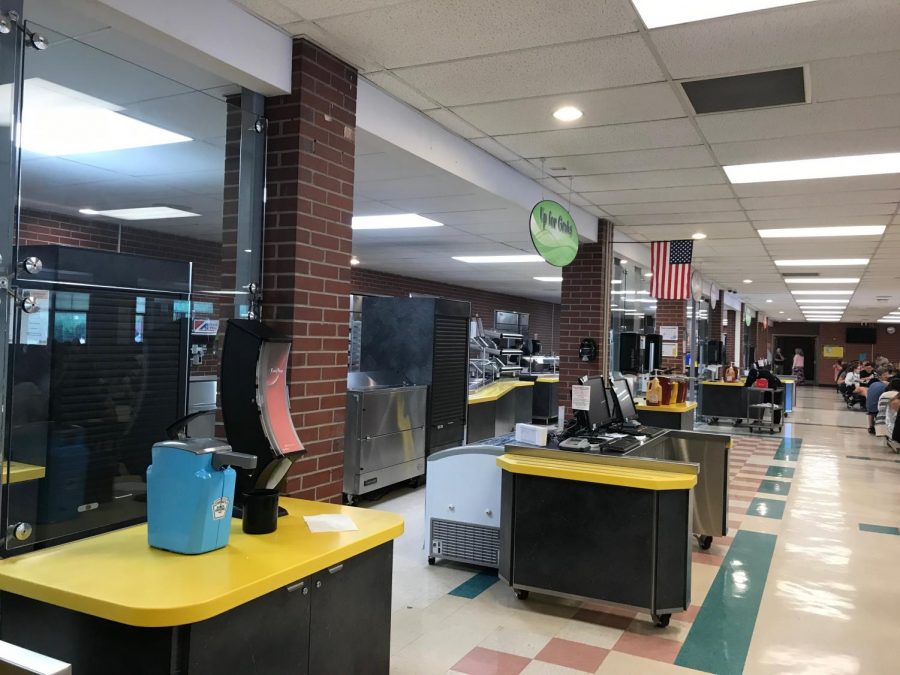You Are What You Eat: Behind the Scenes of School Foods
When you buy a slice of pizza from Pizza Express, french toast from Signature Entrees, or even a bag of kettle chips from the little snack stands, you probably don’t think about all the planning and effort it takes to bring these delicious foods to you in a school cafeteria setting. In school, the foods served to you are chosen and formulated carefully to make sure students are able to make healthy choices starting from before school breakfast, all the way to eighth period eats. NAEye had the privilege of being able to interview several people who are instrumental to one of the most important subjects at school: the food.
Most elementary school kids, when asked what their favorite subject is, will reply with just one word: “lunch”. Although this response is just seen as a clever joke, what most students do not realize is that lunch plays an important role in child development. Active learning takes place in every aspect of a child’s life. Because of this, schools play a key role in forming students’ dietary habits. Here’s how.
National Rules:
Healthy youth initiatives started way back with President Dwight Eisenhower over 60 years ago. More recently, Michelle Obama ramped up battles against childhood obesity with her Let’s Move! campaign in 2010. Her campaign brought a lot of dietary and lifestyle changes to public schools nationwide. These included:
- The Healthy, Hunger-Free Kids Act, which updated school nutrition standards for the first time in 15 years, and also increased federal money allocated to school cafeterias.
- Helping to modernize nutrition labels on food used for commercial use (i.e. making it easier to see calories/calories from fat)
- Decreasing added sugars/fats and increasing the amount/variety of fruits and vegetables consumed
- Refining the classic MyPyramid model (the one we all saw in elementary gym class…R.I.P.) and transformed it into the MyPlate model to better aid families in making the right choices.
- Advocating for better quality of physical fitness
Now, with the Trump administration, certain guidelines have been relaxed and others have been instituted:
- The Department of Agriculture has decreased nutrition standards that were in place through the Healthy, Hunger-Free Kids Act.
- The Obama administration had a rule stating that every type of grain served at school was to be “whole grain-rich”, meaning that any grain (pasta, hamburger buns, etc.) consist of at least 50% whole grains. President Trump has split that rule in half, stating that only half of the whole grains must be “whole grain-rich”
- The Trump Administration also lets schools sell flavored, low-fat milks instead of only non-fat dairy products.
- Finally, the new rules also relax the watch on sodium at schools, which was previously under surveillance by the Obama administration.
State Rules:
As a public school district, North Allegheny receives funding from the state government for basically everything. Since the school uses the state’s money, they have to follow the state’s rules on how to use the money and resources that are given to them. This decree is installed in every classroom, including the cafeteria.
Part of the deal between the state and public schools is that the state is allowed to perform audits regularly. Audits are types of assessments, where representatives from the state come in to check and regulate the cafeteria. Their job is “looking at the efficiency of the kitchen staff, as well as how the cafeteria works,” says Mrs. Ewing. In addition, they take the data gathered at audits (calories, saturated fats, etc.) to reform state guidelines in the cafeteria, so they can improve the quality of public schools statewide.
School Rules!
At NAI, there’s a lot of food around. The cafeteria, Mrs. Jones’ classroom on Pi Day, and the foods classes are just a couple of places where there are an abundance of bites. How does the school regulate all that? We interviewed Mrs. Clawson, a foods teacher; Mrs. Ewing, NAI’s principal; Mrs. Nolan, the cafeteria manager; and Mr. West, the general manager of food services at NA.
Public schools are under strict government guidelines in order to operate at their fullest. Each school must provide a grain, protein, fruit, vegetable, and dairy. In order for the school to receive reimbursements for the food, a student needs to buy 3 out of the 5 food groups listed, and one of them has to be a fruit or a vegetable. Regular meals, such as cheese pizza, cost $2.85, while premium meals (specialty pizzas, pastas, etc) cost $3.85.
It may seem like a struggle to compose a tasty, appealing food that falls within all these guidelines, and that’s where Mrs. Nolan and Mr. West come into play. They, along with others who work in the food department, make sure all of NAI’s food follow the strict government rules.
They have a few trade secrets they spilled to us about eating healthy. To start, they check the first ingredient to see if it comes from a vegetable, fruit/fruit juice, whole grain, dairy, or protein. If the first ingredient does not fall under one of these categories, you will not find it in the cafeteria. Secondly, they use the Smart Snacks Product Calculator, a food calculator that only requires a couple pieces of information for it to figure out if the snack complies with the USDA’s school snacking nutrition standards.
Speaking of nutritious snacks, you might be wondering how certain foods (ahem, Kickstarts) are able to make their way into the hands of most students at NAI. Well, the answer to this is one that you might not know — most brand-name foods (including Kickstarts, Doritos, Lays, etc.) served here are formulated specifically for schools.
Big companies change the ingredients so it falls under state guidelines for school foods and can be served to students. So, most foods found at NAI are one-of-a-kind, meaning that they would not be found at a grocery store.
Learning About Healthy School Eating
The food rules follow students and administrators all the way to the A Hall kitchens, where students can take three “foods” electives: Adventure in Foods, Sports Nutrition, and International Foods. Each of these classes is based around teaching students how to cook different types of foods. We had the privilege to speak with Mrs. Clawson, one of the head foods teachers, about the role of food regulation in her classes. The most educational class on eating healthy is Sports Nutrition.
Although it’s called Sports Nutrition, the class is not based around creating meals for athletes, but rather focuses on educating students about how to select and make healthier meals, as well as find healthier foods while shopping.
A way of promoting healthy eating is to swap one ingredient in a recipe for a healthier option. The class was able to do this by comparing the benefits of chickpea pasta, whole wheat pasta, and white pasta. The analysis allowed students to see and taste all the healthy vs. unhealthy options.
The other foods classes partake in similar activities, but experiencing the effects of healthy eating are limited by other factors, such as the budget the district provides for foods classes. This can limit the ability to buy certain ingredients, like organic fruits and vegetables, and only allows the ingredients to be bought from certain stores.
This restriction on the stores comes from a budgetary standpoint, as only certain stores allow tax exemptions for public schools. When buying from these stores, teachers will have to provide a document that verifies they are buying for a public school. In addition, buying in bulk will also save the school money and is more convenient. (P.S. That’s a pro shopping tip for parents!). The question often raised is how much health is the school sacrificing to save money?
However, there’s a balance in how “health-forward” the class should be. As Mrs. Clawson explains, “[It’s] a bit more challenging, because it’s an elective, so we have to keep kids happy so they continue to take the class, but also open up their eyes.”
In Conclusion
NA has an extremely efficient and forward way of running the kitchens. Although the Trump administration has retired several guidelines, NA has maintained their standards, like stocking only whole grains in the cafeteria. In addition, NA still only provides fat-free milk for students.
However, like anything else, there is, and always will be, room for improvement.
In the classroom, Mrs. Clawson says that student council, along with Mrs. Ferruchie, are working to start several herb and vegetable gardens in the courtyards so that a portion of the ingredients will be from NAI, adding even more meaning to the activities they are used for.
In the cafeteria, things are constantly changing for the better, as the district continues to push for better standards for the students and staff. This could even go as far as replacing the styrofoam trays and plastic utensils with biodegradable materials.
As for Mrs. Jones’ Pi Day parties? NAEye hopes that nothing ever changes in that classroom.

A sophomore at NAI who loves playing soccer, listening to music, and spending time with her friends. She is also on course to set the world record for...

I am a tenth grader at NAI and this is my first year in the newspaper. I play tennis for the school team, and I love doing interviews and interacting with...


